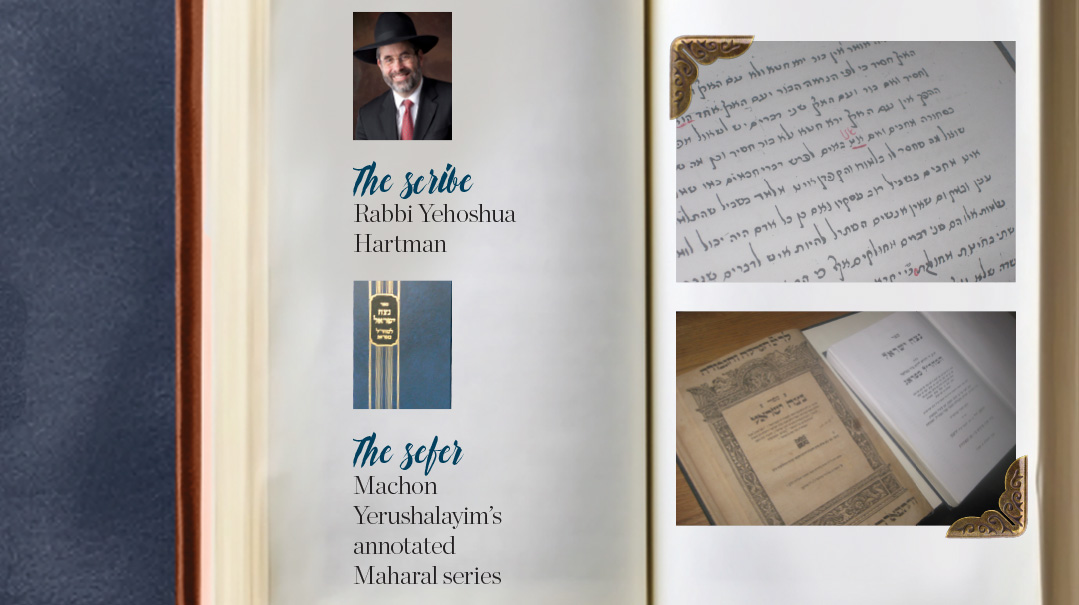A Page from His Book

Who are these talmidei chachamin who have dedicated their talents, time, and skill to disseminate someone else’s Torah?

Project Coordinator: Shmuel Botnick
Lifetime Contract
The scribe: Rabbi Yehoshua Hartman
The sefer: Machon Yerushalayim’s annotated Maharal series
Last week, Rabbi Yehoshua Hartman put out his 40th annotated volume of the writings of the 16th-century gadol the Maharal, Rav Yehudah ben Betzalel Loew: Drush al HaTorah, focusing on Matan Torah. The drashah was delivered on Shavuos 1592 in the Polish city of Pozna. As the 40 volumes to date attest, Rabbi Hartman has long since made peace with the fact that he has a “lifetime contract” with the Maharal, whose corpus of writing contains more words than the entire Talmud.
Even should he complete annotated volumes (actually multi-volumes) of each of the Maharal’s seforim, Rabbi Hartman is contemplating subsequent volumes in which he will gather all the Maharal’s writings on particular mitzvos — Shabbos, tefillin, bris milah, tzitzis, birchos haTorah, tefillah — and show how all the Maharal’s statements on that mitzvah derive from a common root.
The writings of the Maharal, Rabbi Hartman says, “are addicting. They open your mind and elevate you.” He points to Rav Yosef Engel, author of Atwan d’Oraisa, and one of the great lamdanim of the last 150 years, who attributed his entire method of learning to the Maharal.
Rabbi Hartman would be the first to admit that he did not discover, or rediscover, the writings of the Maharal, even though those writings fell into oblivion following the Maharal’s passing.
The Maharal’s towering stature was fully recognized in his lifetime. The Taz refers to him as the “gadol hador” (Y.D. 123). And his greatest talmid, Rav Yom Tov Lippman Heller, in his introduction to his monumental commentary on Mishnah, Tosfos Yom Tov, compares the Maharal’s impact on the study of Mishnah to that of Rabbeinu HaKodesh himself.
Once, Rabbi Hartman delivered a new volume of his annotated commentary to his then-neighbor Rav Ovadiah Yosef, and asked Rav Yosef about the Maharal’s stature in psak halachah. Rav Ovadiah immediately rattled off 40 or so places that commentators to Shulchan Aruch state that the halachah is like the Maharal.
Word of the Maharal’s wisdom even reached the non-Jewish world of his day. He met several times with the great Danish astronomer Tycho Brahe and was invited to the palace of Emperor Rudolph II of Moravia. Even today, Rabbi Hartman points out, the Maharal is the only great rabbi whose grave gentiles wait in long lines to visit.
In his letter of approbation to Rabbi Hartman’s work on Nesivos Olam, the late Rav Shmuel Auerbach attributes the relative eclipse of the Maharal’s writings to the appearance in Europe of the astounding new kabbalistic insights of the Maharal’s younger contemporary, the Arizal, which were brought from Tzfas to Europe by the Shelah Hakadosh. Though there is no indication that the Maharal knew of Lurianic Kabbalah, legend has it that the Arizal said on his deathbed, “There is another like me in the West,” referring to the Maharal.
Not until 250 years after his death were the writings of the Maharal rediscovered by a line of Polish chassidus, extending from Peshischa to the Sfas Emes of Gur. Over the past century, the writings of the Maharal have been fundamental to virtually all of the most prominent baalei machshavah — Rav Eliezer Eliyahu Dessler, Rav Yitzchok Hutner, and more recently Rav Moshe Shapira, and ybdlch”a, Rav Yonasan David.

It wasn’t easy for Yehoshua Hartman to get Rav Moshe Shapiro’s haskamah, as the Rav had never given an approbation before
Rav Dessler gave a copy of Be’er HaGolah to his house bochur Rav Shapira when the latter was 15. Rav Moshe would say later that the Maharal formed the foundation of all his subsequent thought. And it is safe to say that Rav Hutner initiated his son-in-law Rav Yonasan David into the study of Maharal.
And it was Rav Hutner who first pushed the young Yehoshua Hartman to study the Maharal. In 1976, just a few months after the sudden passing of his father Rabbi Yechezkel Hartman, the 19-year-old bochur knocked on Rav Hutner’s door in Jerusalem’s Mattersdorf neighborhood in search of solace. The older Hartman had learned under Rav Hutner in Yeshivas Chaim Berlin from his bar mitzvah until the age of 28, and was one of Rav Hutner’s most prized talmidim.
Reb Yehoshua, who at age 65 retains all the boyish energy and enthusiasm of his young days, still remembers a humorous story about that first meeting. When he entered, Rav Hutner told him, “Shalom aleichem, farmacht di tir [close the door].”
Yehoshua, who did not speak a word of Yiddish, responded, “V’chein l’mar.”
Once Rav Hutner had overcome his surprise that the son of Yechezkel Hartman did not speak Yiddish, the two settled into Hebrew, which Rav Hutner spoke flawlessly, even correcting the Israel-raised Yehoshua’s grammar on occasion.
The two met every third Thursday for the next three years for several hours. Reb Yehoshua remembers those days with longing: “I’m sure that the pleasure of Olam Haba will be even greater, but you cannot begin to understand the pleasure of even the sichas chullin of Rav Hutner.”
Oops! We could not locate your form.







